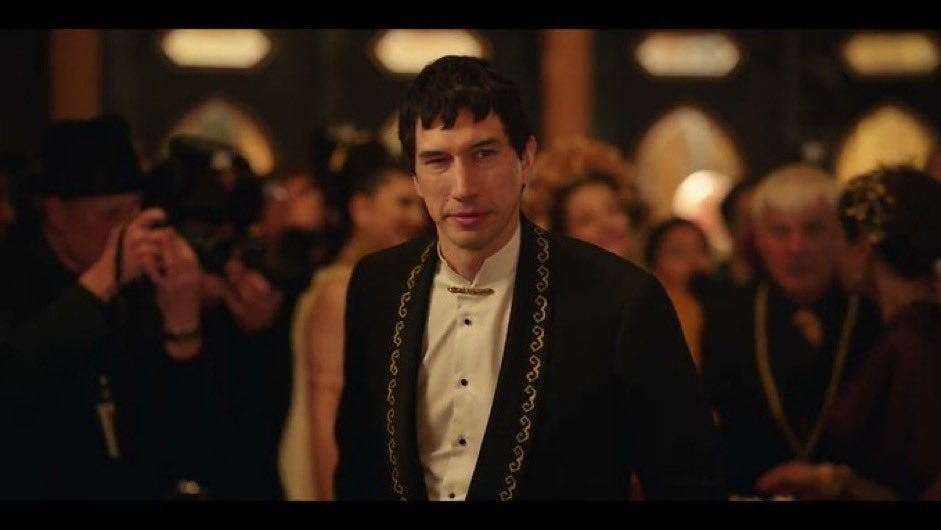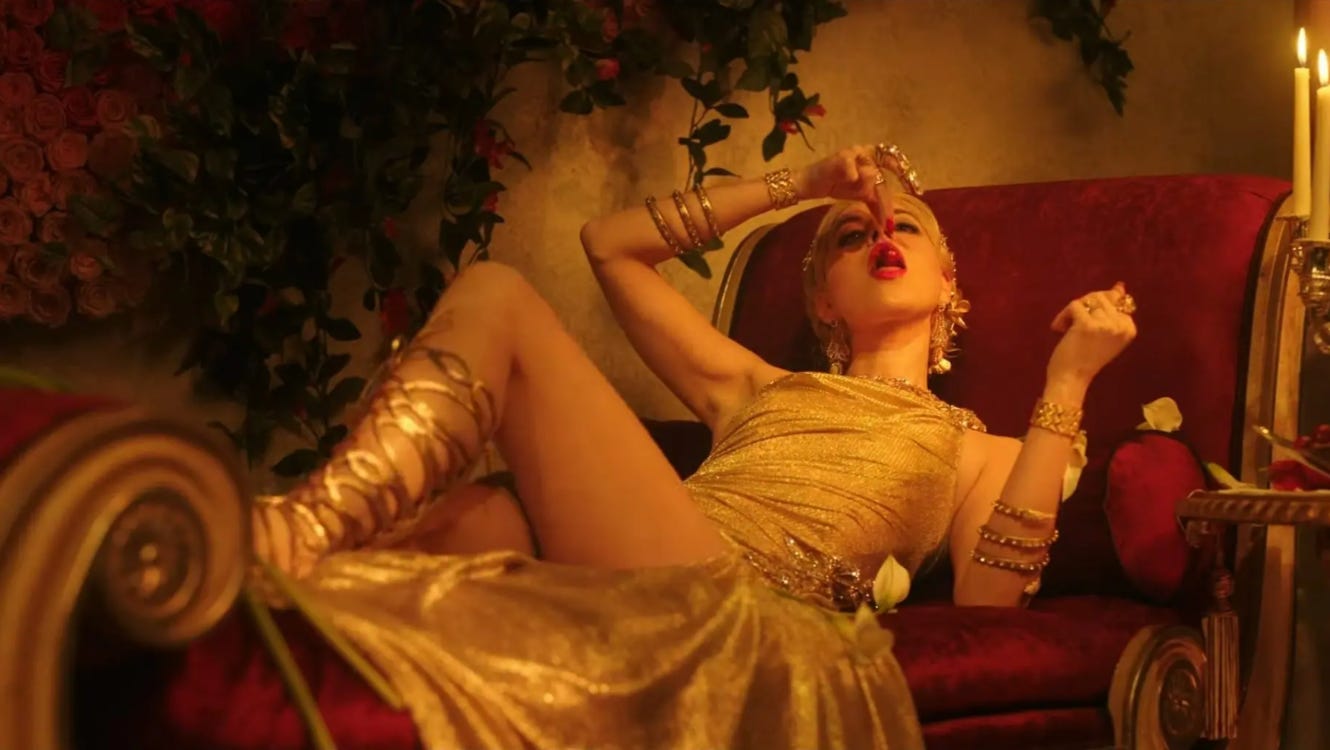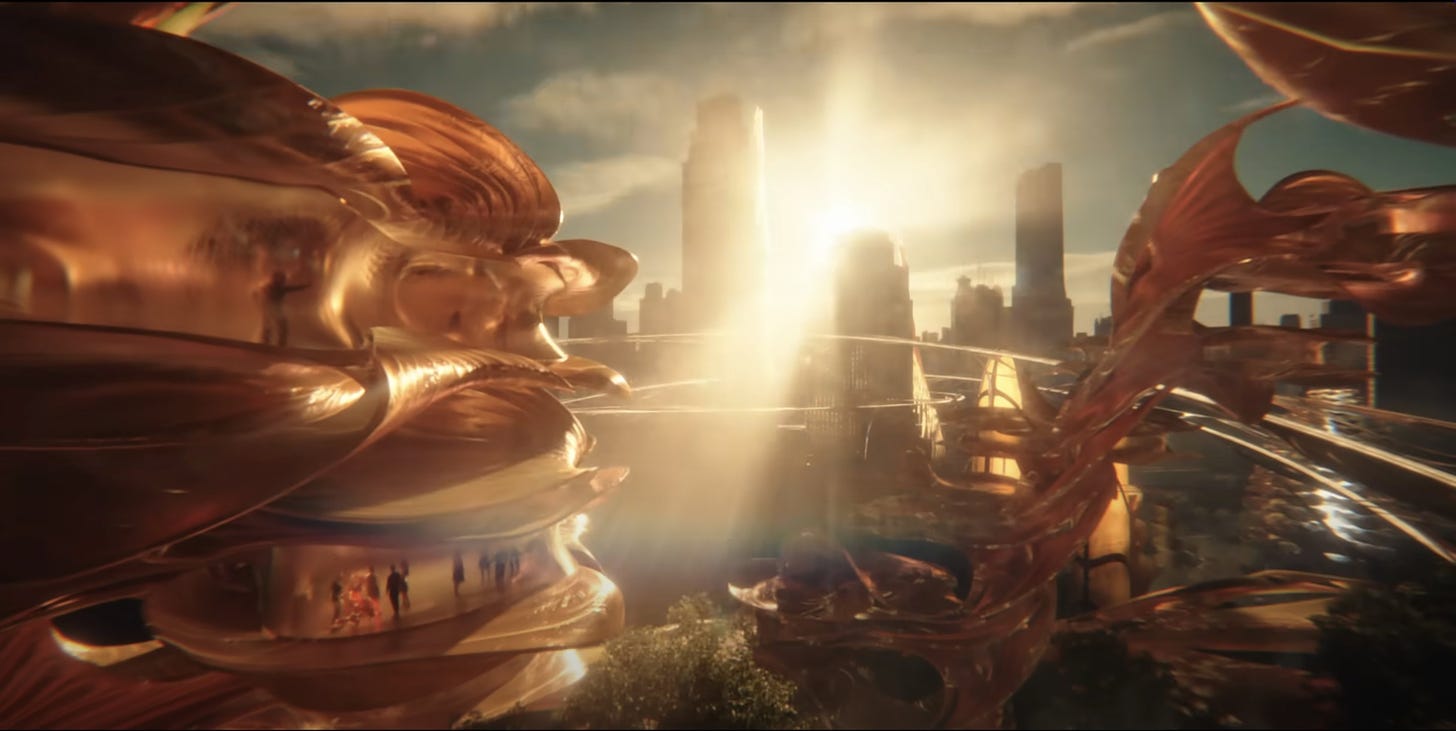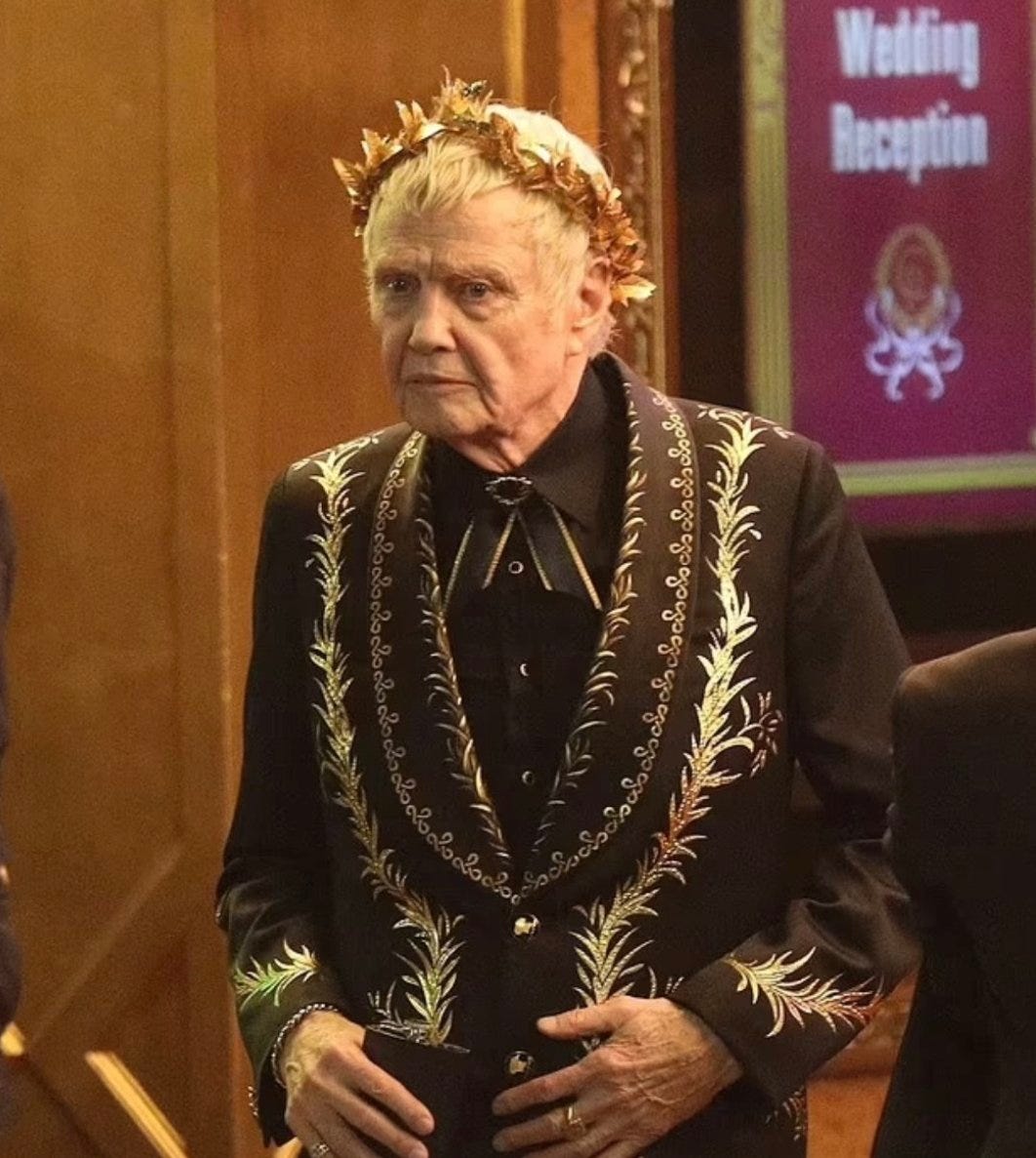- Megalopolis Spoilers Ahead -
Within fifteen minutes of Francis Ford Coppola’s Megalopolis, America has been compared to a late empire Rome. Some similarities are struck: gladiatorial combat, the veneration of virgins, drugs, incest, queers, queer incest, sickening feasts, and… an obsession with fashion. Fashion, to Megalopolis is late-stage empire candy, like chariot races, or spoonfuls of roe, or domming your nephew. Characters pontificate about all the time here, and architecture is allowed to be frozen poetry, prose is venerated and repeated, but fashion is like ladies kissing: a sign that the empire is folding.
This synopsis will not clarify matters, nor fully impart the affect Coppola strikes here. Megalopolis follows an architect, Cesar Catalina, feuding with the mayor of a near future Greco-Romanic New York City as he attempts to rebuild with a material called megalon able to control space and time. The mayor’s daughter falls for the Catalina. He has a tragic past. He is embroiled with newscasters, he’s related to multibillion-dollar bankers played by Hollywood’s least favorite rapists and racists. There are scandals, debates about art and the future, disasters, press conferences, drug trips, assassinations. He also wears a lot of Versace.
I think it’s Versace because Versace is everywhere in this film. Blazers of all kinds come with shiny patterns that sparkle under light. Each comes embroidered with gold imagery, of vase-like leaves or geometric patterns. Shirts have no collars or are replaced with wrapped silks and scarves. Women wear gold belts or brooches or necklaces and Greco-Roman pleats or togas or dresses with animal charms. Even that which is not Versace looks invariably like it. I’ll admit there is some Gucci too, maybe a Fendi shade of brown, a Tom Ford here, a bit of Dolce there. Perhaps some pieces are custom. Megalopolis is a sea of Italian extravagance, a recreation of 1980s Versace glitz as the most modern approximation of what modern Greco-Roman luxury consumption looks like. It speaks to a moment of conspicuous consumption and logomania that expressed new capitalist wealth and expansion, patriotism, nostalgia reclaimed.
The 1980s were, as a reminder, almost forty-five years ago. Versace was what Nomi covets in 1995’s Showgirls. She mispronounces the name, and in mastering the name becomes a master of selling herself. Learning Versace becomes an education in peacocking. A year later in The Birdcage, Versace is the costume of the flamboyantly gay owner of a Miami drag bar. He sometimes wears Dolce & Gabbana.
Gianni Versace’s first show was in 1978 when Coppola was 39. He is now 85.
Coppola writes a scene at a fashion show where elites get their nails done and plot while models covered in metallic wraps strut. The models release their covers to reveal sculptural avant garde dresses, bunches of flowers in delicate monochrome pastels and sculpted synthetic bodices. They are perhaps closest to Iris van Herpen or Nicolas Ghesquiere in their alien naturalism and self conscious artistic value. They look like swirling architecture, warped metal, industry made into fantasy. They receive polite claps, and we are meant to gawk at their awkwardness, their non-functionality, their irresponsibility.
Ironically, the clothes in this scene look like the plans for Catalina’s utopian city of Megalopolis. One is good, the other is not. One can save us, the other cannot. Fashion as regression versus Film as utopia. You can only choose one.
I know I sound hurt, like I was told my favorite toy wasn’t good enough for Mr. Coppola. Still, Versace, fashion, allow insight into the directions and confusions of a film like Megalopolis.
There’s a cyclical aspect of Megalopolis’ rhetoric. The film’s heightened aesthetic of digital Roman glitz & postmodern visual rush is in service of Coppola’s naming the film a fable. Aesthetic creates a layer of shiny symbolism to deconstruct, but what lays beneath the sheen?
Again, facts of plot are inconsequential here. We are meant to revolt over gross overconsumption but celebrate the heroism of a billionaire. We are meant to agree that every person should have a say in their future while protest is trivialized and the power of the people ridiculed. The central struggle of the film is convincing the masses to reject minuscule improvement on a flawed world in favor of reckless utopianism. In the film, that means complete urban reconstruction. In reading analysis of the film’s content you will see phrases like “good Robert Moses“ and “Randian, but…“. Megalopolis has no vision of utopia, the city structures are fluid and naturalistic, like Zaha Hadid buildings in movement. There are parks, people movers, also bubble cars. The point is not why or how it is a utopia, it’s that it is.
On another note, megalon isn’t the only force that can control space and time. Film is another. What is a city built from film, a city repaired by film, a future found through film? Hayao Miyazaki asked this question with last year’s late auteur opus The Boy and the Heron, where Miyazaki is personified as a wizened man who plays with building blocks to escape a sweeter reality. The revelation in Miyazaki's work is the drive to live in the world in spite of, and perhaps because of its pain. Coppola is the architect in Megalopolis, wielding time and space to prove that film is a utopian art. Miyazaki justifies stepping aside by putting the beauty of art in perspective with reality’s beauty, Coppola will only step down if his life’s work can be grandiose, messianic, futuristic.
If then, Megalopolis is an earnest reflection of Coppola’s idea that film form can change the world, shouldn’t we pay attention to the film as formal exercise as much as a rhetorical one? One could see Coppola’s dialogue between architect and a live actor in the theater (at select performances) as a moment in which film transforms space. Heightened tone, comedy, drama, stabs at camp, all form a postmodern “fable“. This takes us back to costumes, “fashion”, Versace. Why do serious people wear tuxedo jackets while city officials don capes and wrapped shirts? Do these garments also elevate fable?
Megalopolis’ Italo-peacock fashion is a sort of retrofuturism - a vision of an absolute luxury of the future built on nostalgia, all from long ago. I think there is a Versace shaped hole in Megalopolis in which the stiflingly dated interferes with this talk of future. As the architect discovers megalon in mourning his wife, Coppola can only paw at the future through the tools of the past.
I’m reminded of a recent article by Thomas De Monchaux about the insidious influence of 1950s and 60s retrofuturism on modern tech. He describes Google’s 2022 Mountain View campus buildings as futuristic spaces devoted to industries of past and present. He writes,
They’re styled—in arguably just the same way that Google can be seen as an old-fashioned entrenched monopoly self-presenting as a beehive of cultural innovation—to look far more ecological and technological than, in their expressionist material excesses, they really are. With their not especially-functional baroque double curves, gratuitous structural stunts, and extraction-heavy materials, and despite the marginal operational fuel efficiencies imparted by their rather credulously lauded geothermal equipment and solar panels, they are an architecture of Peak Oil.
Monchaux also mentions the high energy usage for air conditioning futuristic greenhouse enclosures. He notes Elon Musk’s cheerful language about colonizing Mars in spite of the millennia it would take, he compares the billions Jeff Bezos pours into climate funds versus personal space travel. Retrofuturism seeps into the way we build, but also how we dream. What do the billionaires want? What do they work for?
I think of these questions, of Monchaux and Megalopolis amid very real increasing threats of climate disaster. I laughed at Coppola’s idea of a falling Soviet satellite crashing down to Earth, leveling downtown Manhattan. It’s a fantasy out of the 1950s with post 9/11 imagery. It’s quaint. Easy. Coppola cannot imagine the slow drowning, the battering of hurricanes, the loss of homes, the refugees, the very real threats spurred by fantasy.
Monchaux continues:
In perpetuating retrofuturism, we architects are complicit in the service of certain kinds of power; we participate in the perpetuation of certain delusions. Within our own small profession, this stylistic perpetuation also perpetuates certain habits of obeisance and enforces certain expectations of compliance by architectural subjects and users.
Retrofuturism helps us look away from the anthropogenic climate change–driven cultural and social poly-crisis (now that in only three hundred years we have used up all the burnable fossils); away from the horror of the planet’s current Sixth Great Extinction; and away from the coming sober but creative simplifications of a post-energy-surplus civilization.
When I hear critics applauding Megalopolis on concept alone, that is, a self funded blockbuster intent on starting conversations, I can only see “the perpetuation of certain delusions“. Setting binaries, strict ways of seeing the world are also political, and Coppola’s are stale. In short, the terms of Coppola’s “future“ and “past“ have no bearing on present times.
Aesthetically, that leaves us with a Megalopolis that deals in compliance, in delusions, in “help[ing] us look away from anthropogenic climate change–driven cultural and social poly-crisis.“ Isn’t our empire’s quickening glut made more apt by Versace shades and a bamboo handled Gucci top handle bag? Doesn’t that make our fall look romantic?
The future stops at that vision of Megalopolis/the unnamed fashion show, of wearable industry and technology, of flowing and organic and servile machinery. The future becomes identical across medium, but not all mediums are examined equally. New futures get in the way - to parade in costumes that could disrupt yourself, alter your world, keep you alive, fiddle with your mind, is all the sign of an unhealthy empire. Making a 120 million dollar movie because you can about generalized utopia is the sign of a very healthy empire.
As Monchaux puts it:
At the same time, paradoxically, the retrofuturist style may also encourage a nihilistic denial of life: of yet unfulfilled potentials and discoveries and so of our duty to the future, to our descendants, near and far. It diverts our gaze from the future to the past by reinforcing an assumption that the past’s imaginary future was better than our own could ever be—and that therefore we should substitute that old vision for whatever our own might become.
As soon as you see someone actually thinking about the future, about film, about restructuring our lives, Megalopolis falls apart.
Megalopolis is best experienced as late capitalist sparkle, a bizarre ironically unmarketable dazzle of nonsense. It’s a Versace blazer more than an Avant gown, not transformative but comfortably retrospective. It makes the mess of our future enjoyable. At least, for a moment.








